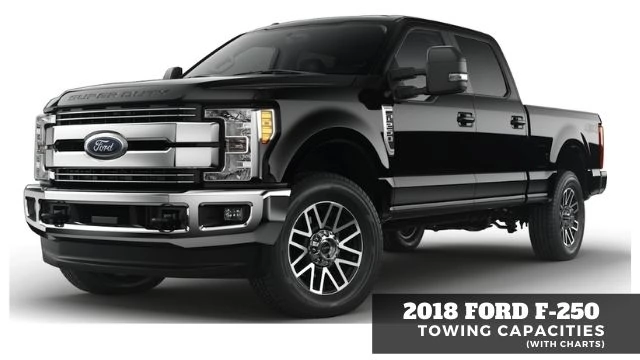The 2018 Ford F250s had similar specs to the other model years that were made around the same time and were also able to achieve an 18,500 lb. maximum towing capacity, if your truck was properly equipped. There were a lot of variables that were listed in the charts that contributed or affected the overall weight ratings, which I go into more detail about in this article.
You need to make sure you have these specific items equipped because at the other end of the spectrum, you were looking at a much smaller 12,200 lb. capacity if your truck did not have these essential items installed.
Read through your owner's manual to familiarize yourself with your truck and be sure that you adhere to all of Ford's requirements and recommendations.
2018 F-250 Overview
Overall Towing Capacity: The towing capacity for the 2018 F250s ranged from 12,200-18,500 lbs. How much capacity your truck was capable of depended on many different factors, but the two biggest factors included the engine you had equipped in your truck and the axle ratio.
Engine Options: There were two different engine options for these trucks and this was either a 6.2 L engine that used gasoline or an optional 6.7 L engine that was diesel-powered.
The 6.2 L engine was still quite capable, having a maximum capacity of a little over fifteen thousand pounds, but the 6.7 L diesel engine had a much higher limit, coming in at over 18,000 lbs., if you had the proper equipment installed on the truck.
Axle Ratios: There were four different axle ratios that were offered for these trucks, two axle ratio options for each engine option. If you had the 6.2 L engine installed in your truck, then you had the choice between either a 3.73 or 4.30 axle ratio.
If your truck was equipped with a 6.7 L engine, then your two axle ratio choices were limited to a 3.31 or 3.55 axle ratio.
Assumed Weight: The maximum trailer weight ratings were specified and Ford made the assumption that a driver and a passenger were in the truck and each weighed 150 lbs., which brought the total assumed weight of both occupants in the vehicle to 300 lbs. combined.
Standard and Gooseneck Charts:
The 2018 F250 charts were divided up depending on the type of hitch you were using and is why there are two different charts, one for conventional hitches and another chart that is for fifth wheel and gooseneck hitches.
There is a lot of information to look through, which you can see if you look at the image of the chart below, and you will need to plug in certain elements of your vehicle into the charts in order to get an accurate representation of your maximum trailer weight rating.
These things can include the cab configuration that you have on your truck, the axle ratio, what engine you had equipped, your wheelbase length, your bed length and finally, whether you had a two-wheel drive or four-wheel drive model. You will have to plug in all of these variables in order to get your trailer weight rating.
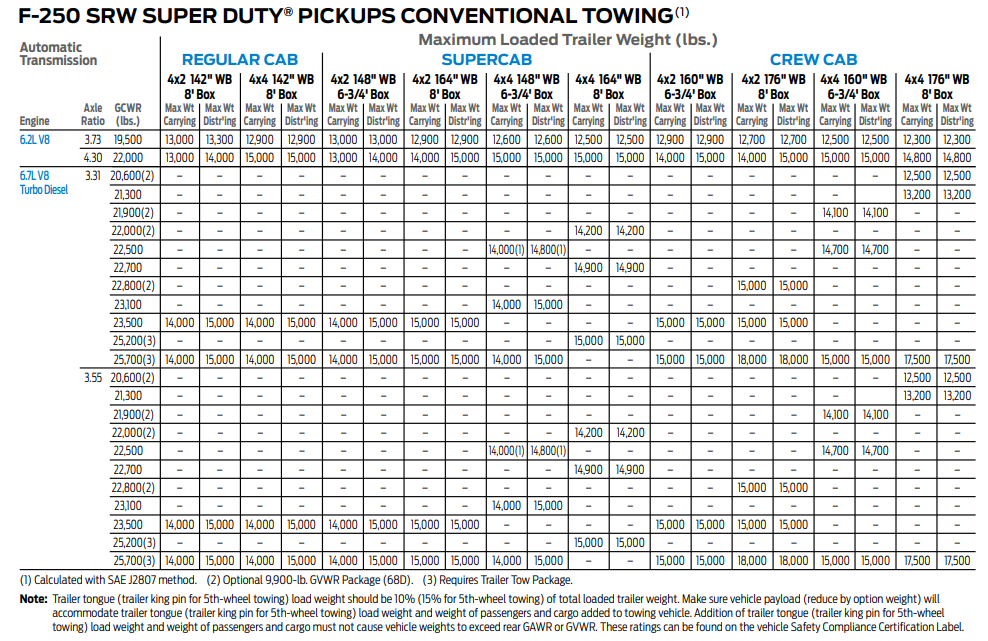

There was also additional information that I was able to find on the trailer frontal area recommendations made by Ford, along with the tailgate clearance heights, if you are planning on using a gooseneck or fifth wheel hitch.
Trailer Frontal Area Considerations

Tongue Weight Rating:
The tongue weight rating specs were shown at the bottom of the charts, in the image I have posted above and if we read the fine print, we can see that Ford recommended a tongue load weight rating of 10% on your vehicle for conventional hitches and 15% for fifth wheel or Gooseneck hitches.
I do want to mention that in the owner's manual, I found a note that states that you should not go below or above 10 to 15% of the trailer's maximum weight if you were using a conventional hitch and the same was true for gooseneck and fifth wheel hitches, but that percentage was increased to between 15 to 25%.

What Axle Ratio Do I Have?
One of the first things you have to decipher on your truck is the axle ratio and you will need to know what this is in order to get an accurate weight rating. You can find this information on your certification label that is located on your driver side door, or sometimes the door pillar itself.
The certification label will look like it does on the image I have posted below and will contain a lot of helpful information within it, but it will also have an axle code that you need to know. This axle code will be located at the bottom of the label, close to the middle and we'll have a two-digit code that you need to jot down.
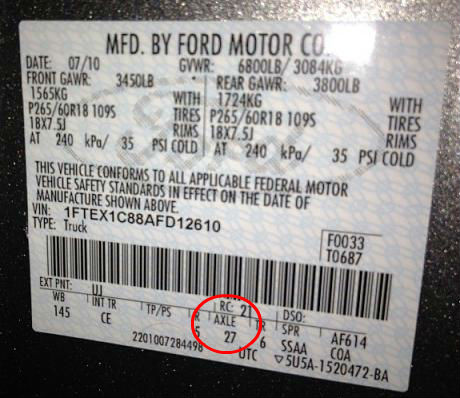
After you have this code, you'll need to plug it into the chart that I have listed below, as it will decipher the two-digit code for you and reveal what rear axle ratio you have on your truck. This chart is not only for the F250 series trucks but for the F350s, the F450s and the F550s, so I went ahead and outlined the four different axle ratios that apply to the F-250 trucks.
It doesn't matter if you have a limited slip, non-limited slip or an electronic locking rear differential, as the only important information that we need is the axle ratio, so we can plug that into the charts.
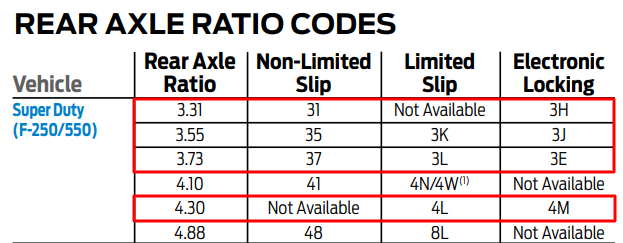
Wheelbase Length:
Making our way down the list, we will also need to know the wheelbase for our truck and if you are unfamiliar with this measurement, it is simply just the measurement from the front to rear wheels and is measured from the center of each wheel.
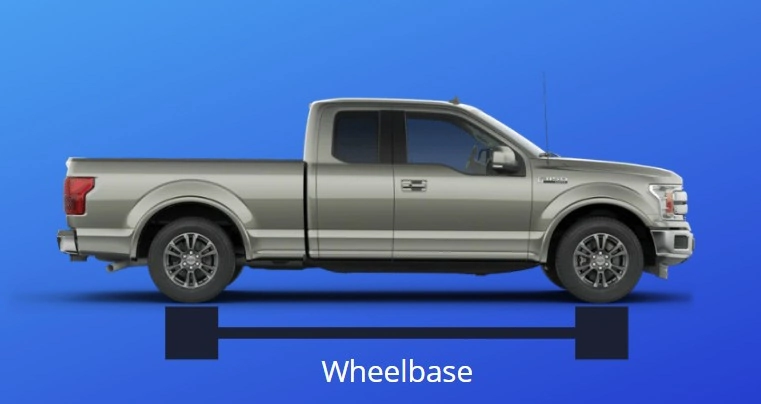
Bed Length (8' & 6 3/4' Box):
The next variable that you will need to figure out is what the specific bed length of your truck is, either an 8 ft bed or a six and three-quarter foot bed. These are more commonly known as a long bed in a standard sized bed and you will have to measure these, in most cases, to get an accurate figure.
When you are measuring the bed, the 8-foot bed will usually come in at around 98 in. long, so slightly longer than 8 ft and the six and three-quarter foot bed will measure roughly 81 in. long.
Weight Carrying and Weight Distributing:
If we look at the charts again, we can see two different figures in the conventional chart, one figure states a weight-carrying metric, and to the right of that, another metric that's labeled weight-distributing.
Most people are going to want to look at the weight-carrying metric, as it is the specific number that you need when just using a conventional hitch. The weight distributing figure is for those of you out there that are using a weight distributing hitch, in conjunction with your traditional hitch setup.
Trim Levels Explained:
There were are many different trim levels available for these 2018 trucks and these were labeled by Ford as the: XL, XLT, Lariat, King Ranch, Platinum and Limited trim levels. Don't worry too much about the trim level that you had equipped on your truck because it did not affect the maximum trailer weight ratings directly.
Other factors affected the numbers instead and the only thing that would limit you regarding your trim level would be the options that were available to you for that specific trim level.
For instance, the XL version of the truck may not have had the option of having the diesel engine available, so you would not be able to get those specific weight ratings that were listed for that engine.
Cab Styles...
There were also three different cab styles or cab configurations that were available for these trucks and is another variable that you will have to decipher in order to get your weight rating.
The image below shows the three different cab styles that were available and these were: a regular cab, a super cab and a crew cab. The regular cab and super cab were both two-door models, but the super cab had an extended area behind the front seats for additional passengers and the crew cab had four doors, giving you a much larger rear area for passengers.
GVWR and GAWR Figures:
GVWR & GAWRs: It Was really convenient that the gross combined weight ratings were listed in the charts, right next to the axle ratios but I was not able to find the gross vehicle weight rating or the gross axle weight ratings anywhere in any of the literature.
Certification Label: In order to get your gross vehicle weight rating and gross axle weight ratings, you will have to look on the certification label again, which is the same label where we found our axle ratios earlier. At the top of this label, you will find the gross vehicle weight rating, along with the front axle weight rating and rear axle weight rating.
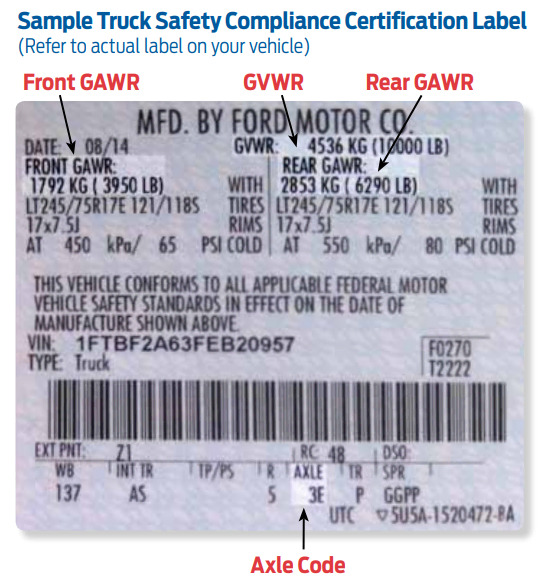
Standard Equipment & Tow Package Options...
The 2018 F250s did have a lot of the tow equipment that you needed as a standard option and I was able to find a chart that shows you what equipment was included, along with the optional tow package that was also available for trucks that had the 6.7 L diesel engine equipped. The additional package was labeled as the 535 package.
I do want to point out, that some of the standard options were for the F350s and F450s, not the F250s, which the notes that I have included at the bottom of the image explain.
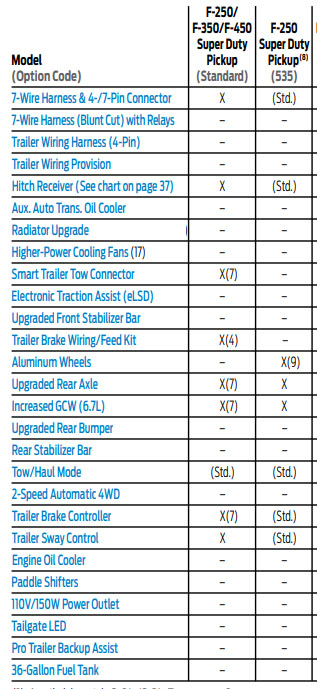
(4) In-cab, no controller (SRW). (7) F-350 DRW/F-450 only. (8) Requires 6.7L diesel engine. (9) Polished (Platinum).
Trailer Brakes:
It Is important to mention trailer brakes when talking about trailers because the additional weight that it puts on your truck is too much for your truck's brakes to handle, so you will need a additional brakes that are installed on your trailer in order to compensate for the additional weight that the vehicle is pulling.
Ford requires that you have trailer brakes equipped on your trailer if it weighs 1,500 lbs. or more and is pretty standard for almost all model year F250s. Each County and State has different laws and vehicle codes when it comes to trailer brakes and trailer weight ratings, so you will need to check your local laws to see if that 1,500 pound rating is enough to satisfy their requirements.
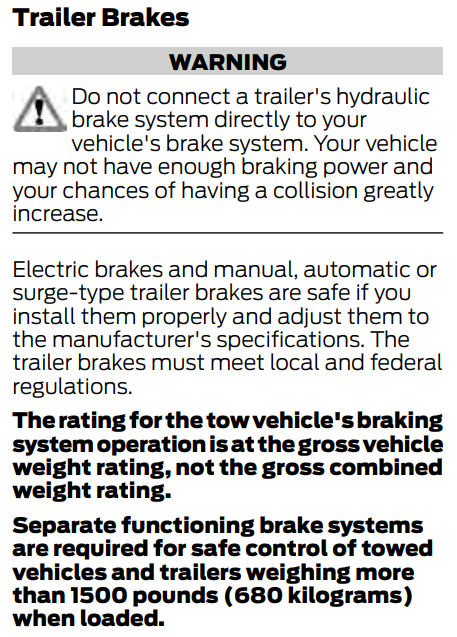
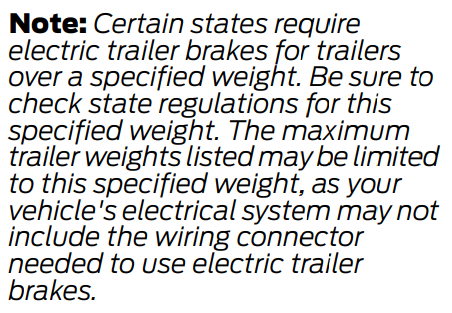
Other Notes I Found:
There were a couple of additional tidbits of information that I found in the owner's manual that I think are worth mentioning and the first bit of information talks about higher altitude areas and if you are in these types of areas, you will have to reduce the gross combined weight rating by 2% for every 1000 feet of elevation change.
The other bit of information I found talked a little bit about the recommended octane of gasoline, which would only apply to trucks that had the 6.2 L engine equipped.
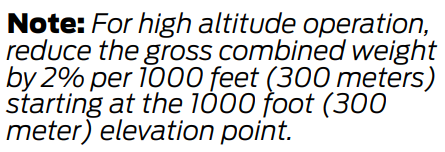
Sway Control Requirement
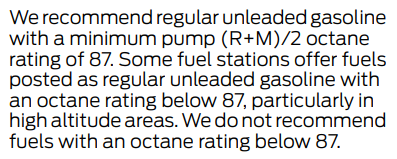
Sway Control Requirement
Helpful Links:
There were only three different resources I used to gather all of the information for this article, but it was more than enough to provided me plenty of images and information to cover the topic thoroughly. I wanted to link to these three resources below, for those of you out there that want to dive a little deeper into the data yourselves.
Last updated on April 27th, 2022 at 06:47 pm
